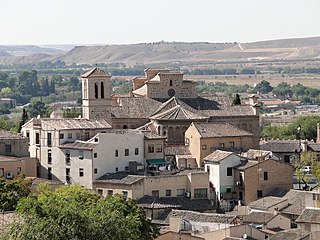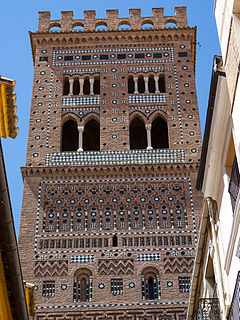
The Metropolitan Cathedral Basilica of the Holy Saviour or Cathedral of San Salvador is a Roman Catholic church and minor basilica in the centre of Oviedo, in the Asturias region of northern Spain.
Las Herencias is a municipality located in the province of Toledo, Castile-La Mancha, Spain. According to the 2006 census (INE), the municipality has a population of 759 inhabitants.. It adjoins the municipalities of Talavera de la Reina in the north, La Pueblanueva and San Bartolomé de las Abiertas at the east, Alcaudete de la Jara and Jara Belvís the south, and Calera y Chozas to the west, all of Toledo.

San Sebastian is one of the oldest churches of Toledo, Spain. It once was close to the former city gate called "Bab-al-Dabbagin" also known by its Spanish name as "Puerta de los Curtidores". Archeological research shows that it was originally built as a mosque in the 10th century, and enlarged in the 11th century. The mosque was called Al-Dabbagin., sometimes transliterated as Adabaquín. Some time after 1085 it became the church of one of the six Toledan parishes of the Mozarabic rite. The architectural reconstruction dates from the late 12th or 13th century.

The Mezquita-Iglesia de El Salvador is a church in Toledo, Spain completed in 1159.

The Iglesia de San Román is a church in Toledo. The church was built in the Mudéjar style in the 13th century. In this site there was an old Visigothic structure and probably an ancient Roman building. It is currently the headquarters of the Museum of the Councils and Visigothic Culture.

The Iglesia de San Lorenzo is a church located in Toledo, Spain. It was built on the site of a mosque dated to the first half of the 11th-century. In 1121 the church is mentioned for the first time, as a Mozarab parish church dedicated to Saint Lawrence. In the 18th-century the San Lorenzo was renovated, expanding it.

La Jara is a comarca located in the Montes de Toledo at the western end of Toledo Province, it also includes the municipality of Anchuras, an enclave of the province of Ciudad Real, in Castile-La Mancha, Spain. The comarca's capital is Los Navalucillos, however Talavera de la Reina is an important city for local people in La Jara owing to historical ties, even though it is located outside of the comarca.

The Cave of Hercules is a subterranean vaulted space dating back to Roman times located in the alley of San Ginés in the city of Toledo, Spain. The cave is under a building located where the Church of San Ginés, Toledo stood until 1841.
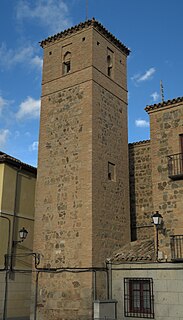
The Tower of San Cristóbal is a Mudéjar tower belonging to the Church of San Cristóbal in Toledo (Spain).

The Hospital de Tavera, also known as the Hospital de San Juan Bautista, Hospital de afuera, or simply as Hospital Tavera, is an important Building of Renaissance style that is in the Spanish city of Toledo. It was built between 1541 and 1603 by order of the Cardinal Tavera. This hospital is dedicated to John the Baptist and also served as pantheon for its patron, Cardinal Tavera. Initially it began to be constructed under the supervision of Alonso de Covarrubias, being succeeded by other architects and finishing the work Bartolomé Bustamante.

The Puerta de Alcántara is a city gate located in Toledo, in Castile-La Mancha, Spain. It gives access to the interior of the historic center of the city, passing through its eastern side the surrounding wall. It is in front of the Bridge Puente de Alcántara, that crosses the Tagus river and that in turn is protected by two gates fortified in its ends.
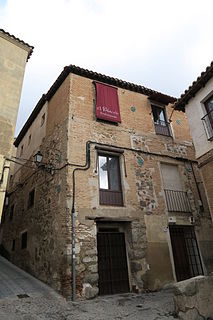
The so-called Templar House in Toledo, in Castile-La Mancha, Spain, was built and decorated between the years 1085 and 1114, belonging to this period the general structure, typically Al-Andalusian, supported by the vaults of the basement and organized around the courtyard. The strict contemporaneousness existing between this monument of Toledo, the Aljafería palace of Zaragoza (1046–1082), and the roofing of the church of San Millán of Segovia is shown by the fact that the large majority of the construction elements for the roofs and ornamental designs are practically the same on all three buildings.

The Iglesia de San Miguel el Alto is a Mudéjar church located in Toledo. It is one of the old Latin parishes of the city of Toledo. Apparently, this church was in relation to the Knights Templar being founded by them, serving as chapel or oratory of the inn for the knights of this order.

The Iglesia de San Ildefonso is a Baroque style church located in the center of the historic city of Toledo, in Castile-La Mancha, Spain. It is also known as the Jesuit church and is consecrated to Saint Ildefonso of Toledo, patron of the city and Father of the Church.

The Iglesia de San Lucas is located in front of the Bu hill at southeast of the city of Toledo, Castile-La Mancha, Spain. In a high wall, attached to the church, was located the old parish cemetery, where it is told that the last Mozarabs of the city were buried.
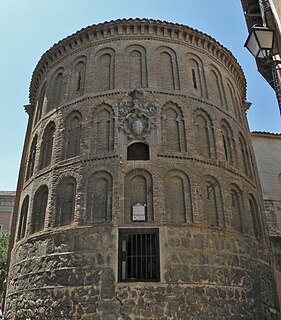
The Iglesia de San Vicente is a church located in Toledo, it appears as a parish already in 1125, although, there is documentation that speaks of that was founded by Alfonso VI shortly after the conquest.

The Iglesia de Santa Leocadia is a church located in Toledo, in Castile-La Mancha, Spain. The Toledan tradition maintains that this church is built on the site of the house where Saint Leocadia of Toledo was born, to which would belong a small underground room, where it is affirmed that it made prayer. This cave corresponds to the crypt located next to the right pillar of the presbytery, and is covered with a plaster crossery vault, which can be dated in the first half of the 16th century. In the tower and in the facade of the church are preserved, embedded, some fragments of Visigothic style's reliefs.

The Iglesia de los Santos Justo y Pastor, popularly known as Iglesia de San Justo, is a church located in the city of Toledo. It was founded after the city was taken by King Alfonso VI of León and Castile in the 13th century. The city underwent transformations between the 14th and 18th centuries. This is a religious temple under the invocation of the holy children Justus and Pastor.

The Convento de la Madre de Dios is a Dominican convent located in the city of Toledo. It was founded at the end of the 15th century as a nunnery by Leonor and María de Silva, daughters of the Count of Cifuentes. It was a cloistered monastery, a Guardia Civil barracks, and finally a university campus after its acquisition by the University of Castilla-La Mancha to expand the facilities of the Faculty of Juridical and Social Sciences.

The Convento de San Pedro Mártir, is a convent located in Toledo. The Dominican convent was moved in 1407 from its location outside the walls to the houses donated by Doña Guiomar de Meneses. through its successive extensions and modifications, became one of the richest and most important convents of the city.





